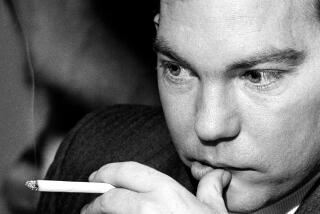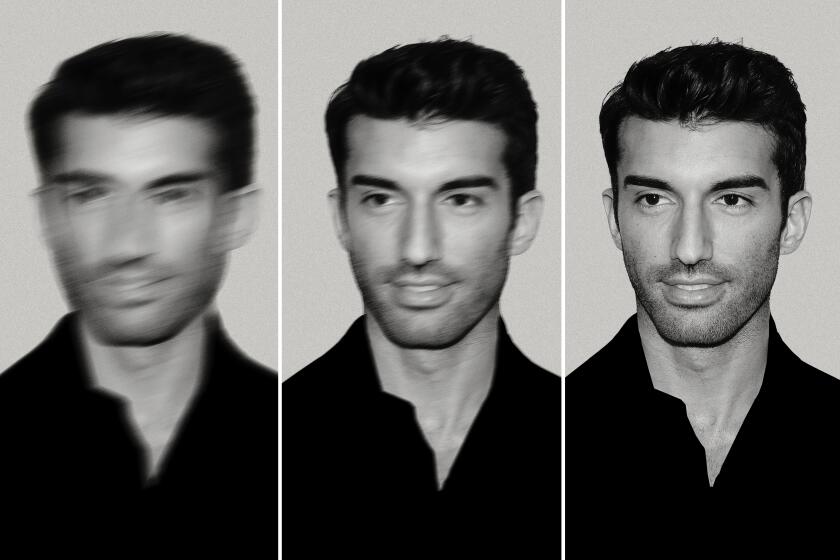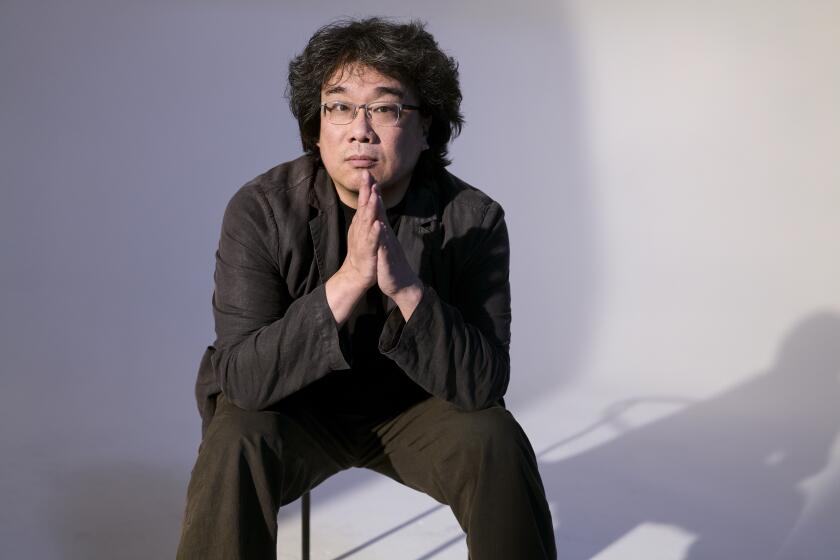The Road to ‘Heaven and Earth’ : How Le Ly Hayslip’s Personal War Inspired Oliver Stone
- Share via
Let’s play this story as a short movie in our heads. An Oliver Stone movie, with multiple flashbacks, quick cuts and plenty of dense political observations. It’s the only way to tell a story that covers two mirror-opposite lives, two radically different cultures, and the most divisive foreign war in American history.
The lives are those of Stone, the Oscar-winning director of “Platoon” and “Born on the Fourth of July,” and Le Ly Hayslip, the real-life subject of Stone’s “Heaven and Earth,” the epic tale of a Vietnamese rice farmer’s daughter who was aiding the Viet Cong at age 12, selling black-market goods to U.S. soldiers like Stone in Da Nang at 16, marrying a 55-year-old American businessman at 19 and descending into domestic hell as an immigrant housewife in San Diego at 20.
“Americans went to Vietnam and found hell,” says Hayslip, who now lives in San Diego and heads an international foundation devoted to bridging the cultural gaps between East and West. “I came to America and found it.”
“Heaven and Earth,” which opens Saturday, tells that story, how Hayslip (played by newcomer Hiep Thi Le) spent the first 20 years of her life as a peasant, prostitute, single mother and hustler in Vietnam, events chronicled in her first autobiography, “When Heaven and Earth Changed Places,” and the next 15 trying to adapt to an American lifestyle that turned her Buddhist view of the world upside-down. She recalled those chapters of her life in her second book, “Child of War, Woman of Peace.”
Stone used both books and both settings and compressed four abusive American men in Hayslip’s life into one character, played by Tommy Lee Jones, in the film.
Our story is about how the divergent, contemporary lives of Stone, 47, and Hayslip, 44, intersected to produce a major motion picture.
For the opening scene, we’ll cut back and forth from Hollywood, where Stone has just been anointed with the 1986 best picture and best director Oscars for “Platoon,” and San Diego, where a lone Vietnamese woman is standing outside a theater passing out flyers to patrons who have just seen his picture.
“I am not against the movie,” Hayslip says, recalling the incident several years later. “But I want them to know that 3 million of my people died in that war too.”
Back in Hollywood, Stone is basking in a critical, commercial and fraternal success few filmmakers have ever known.
“This was a spectacular moment in my life,” Stone says. “Having been rejected and neglected so long, to have all that happen, it was a glorious time.”
Neither Hayslip nor Stone knew anything of each other then, in early 1987, and wouldn’t until Stone read her first book two years later. But both Hayslip and Stone say they may have met before, if not on a spiritual plane, as Hayslip is certain they have, then on the streets, perhaps, they both suggest, even between the sheets, in Vietnam.
To continue: We’re looking at a busy street scene in 1968 Da Nang, where a young Vietnamese woman is approaching an American soldier with a basket filled with black-market goods. Some Scotch, some cigarettes, a jumble of sunglasses and sandals, and, beneath it all, some pot.
She speaks in badly broken English, and the soldier nods, hands her some money and walks off with his purchase. Or maybe they leave together and go to her place, where he buys something else.
Such scenes were played out thousands of times a day, and one of those transactions might have involved Army pilot Stone and the girl then called Phung Thi Le Ly.
“We could have crossed paths very easily,” Stone says, recalling his tour stationed near Da Nang in 1968. “I could have walked by her a hundred times. In fact, who knows, she was a prostitute . . . .”
“It’s very hard to say if we met,” Hayslip says, in her heavily accented English. “I may have served him a drink, I may have served him marijuana. I may have been in bed with him. I don’t know.”
Life is filled with brief encounters, but war creates the strangest and briefest. Consider who Stone and Hayslip were in 1968, a year that saw an escalation in both the war in Vietnam and the anti-war movement at home.
A montage of Stone’s life to that point would take us over the relatively dull course of a successful Wall Street stockbroker’s son living a life of privilege in New York City, with boarding schools leading to a year at Yale and to an impetuous six months abroad as an English teacher in 1965 Saigon.
Stone went home for a year, then made a second trip to Vietnam with the U.S. Army, being awarded a Bronze Star and a Purple Heart while fighting in a land whose people he, like many Americans, thought of as nearly subhuman.
A montage of Hayslip’s life, which is re-created in detail in “Heaven and Earth,” shows us a child living in the cross-fire of the Viet Cong and South Vietnamese forces, both sides demanding loyalty from the peasants and doling out quick punishment to those failing to comply.
Le Ly went to school for only three years, worked 14-hour days in the rice paddies and vegetable garden, became a child gofer for the Viet Cong, and, at 14, was imprisoned, beaten, tortured and raped by the South Vietnamese. In 1965, as Stone was dropping out at Yale, she moved to Saigon with a friend of the family and a year later had his son, out of wedlock.
In 1970, Stone was studying film at New York University, while Le Ly was fleeing Vietnam with the American civilian who came to her country determined to bring an Asian wife home to San Diego. She had just had her second son by this stranger, 35 years her senior and dying of emphysema.
In 1975, as Saigon was falling before our eyes on television, Stone began writing notes for a Vietnam combat movie based on his own experiences but done in the heroic style of Greek mythology. Le Ly, a widow for three years, was marrying the troubled, violent Dennis Hayslip and enduring the hatred of people who thought of all Vietnamese as enemies.
In 1982, “Oliver Stoned,” as he had become known, shed some demons with his script for the cocaine thriller “Scarface,” and Hayslip shed one of her own, inadvertently, when her second husband died of an apparent suicide.
In 1986, as Stone was shooting “Platoon” in the Philippines, Hayslip made her first pilgrimage to Vietnam and was so shocked by the postwar conditions there--fatherless households, disease, misery--she decided to sell her thriving Vietnamese restaurant in America and devote herself tobringing the plight of the Vietnamese to world attention.
In 1992, three years after Stone optioned Hayslip’s first book, and after they had spent weeks visiting her mother’s house in Ky La, she took Stone to her master, a Buddhist monk in California, who put the lapsed Catholic through a soul-cleansing ritual called Quy Y and gave him a Buddhist name, Minh Duc, which, a shock to his foes, means “virtue and brilliance.”
So, these two very different lives have not only led to a movie, they’ve altered each other. Stone says that he has always favored Eastern philosophy over Western and that he was moving toward Buddhism when he met Hayslip. His conversion was completed, he says, when he went with her to Vietnam. On his return, he quietly donated money to build and operate two medical clinics in Vietnam, and Hayslip, whose fees are deferred to her East Meets West foundation, says more are planned.
Few subjects of film biographies have had the input on their own life’s story as has Hayslip, who worked with Stone during every day of the shooting in Thailand and Southern California. Other than the compressed version of her four faulty romances, she says the story is accurate right down to a couple of lines of dialogue that can have no real meaning to anyone but her.
Still, having a movie made about her life shouldn’t be considered a happy ending, or an ending of any sort.
“I am writing a third book now,” she says. “It’s about the making of the movie and other things. This movie is just one chapter in my life. I have half my life still to live.”
More to Read
Only good movies
Get the Indie Focus newsletter, Mark Olsen's weekly guide to the world of cinema.
You may occasionally receive promotional content from the Los Angeles Times.










